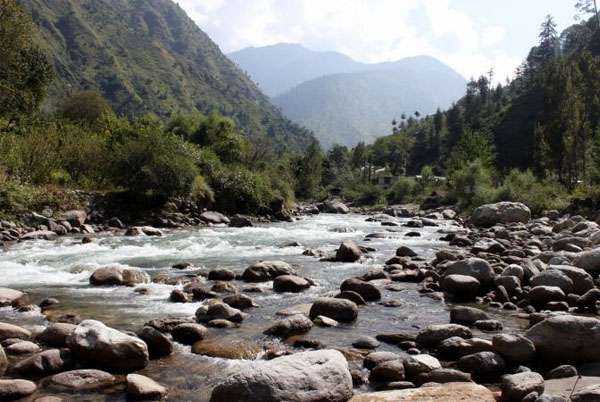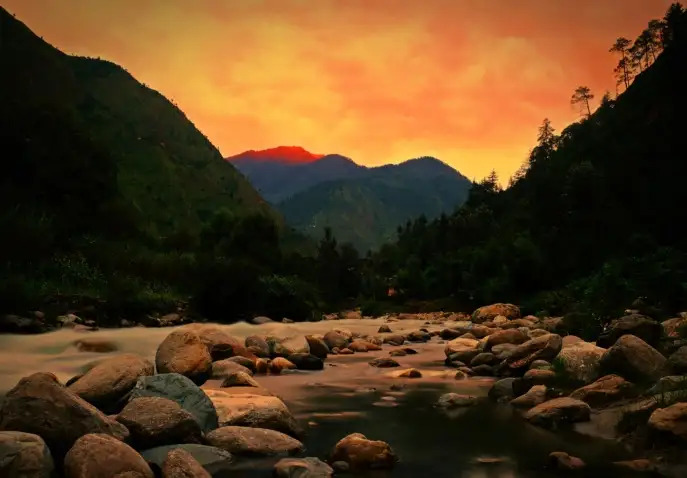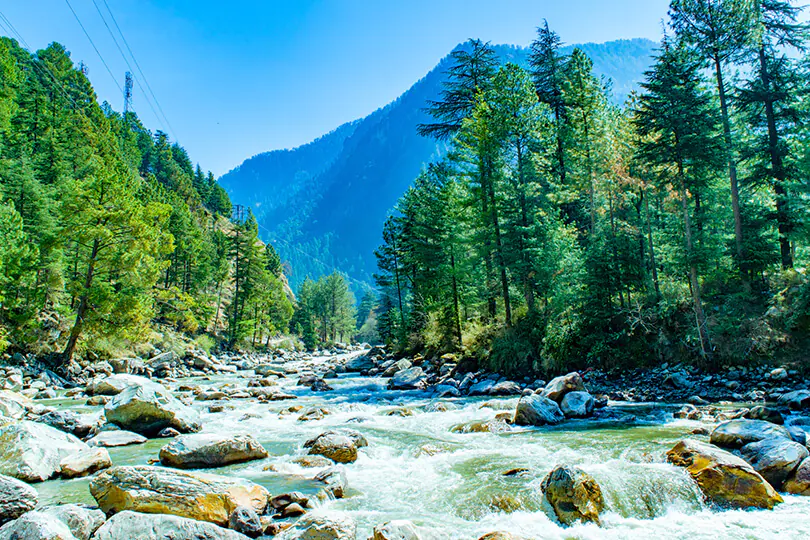


Tirthan Valley is an elegant and serene valley located in the Kullu district of Himachal Pradesh, India. The valley is situated along the Tirthan River, which is a tributary of the Beas River. The valley is surrounded by majestic mountains, dense forests, and breathtaking landscapes, making it an ideal destination for nature lovers, adventure enthusiasts, and peace seekers.
Tirthan Valley is home to a diverse range of flora and fauna, and is a popular spot for trekking, camping, and fishing. The Great Himalayan National Park, a UNESCO World Heritage Site, is also located in the vicinity of Tirthan Valley.
The valley is dotted with small hamlets and villages that offer visitors a glimpse into the local culture and way of life. The people here are warm and welcoming, and the food is delicious, with a focus on local Himachali cuisine.
Tirthan Valley is a perfect destination for those looking for a peaceful retreat away from the hustle and bustle of city life.
Tirthan Valley has a rich history that dates back to the 16th century when it was part of the Kullu Kingdom. It was an important trade route between Kullu and Kangra valley during that time. The valley was named after the Tirthan river, which flows through it and is considered sacred by the locals.
During the British era, Tirthan Valley served as a hunting ground for the British officers. Later, after independence, the valley remained secluded and largely untouched by modernization. In recent years, it has become a popular tourist destination, known for its natural beauty and adventure activities.

Tirthan valley is easily accessible via railways, roadways, and airways.
The nearest airport to Tirthan Valley is Bhuntar Airport, located in Kullu district, about 48 km away. From the airport, you can hire a taxi or take a bus to reach Tirthan Valley. It takes around 2 hours to reach Tirthan Valley from the airport.
The nearest railway station to Tirthan Valley is Joginder Nagar Railway Station, which is approximately 143 km away. It is a small railway station and only a few trains stop here. Another option is to take a train to Chandigarh Railway Station or Ambala Cantt Railway Station and then take a taxi or bus to reach Tirthan Valley.
Tirthan Valley is well connected by road to major cities in North India. The easiest way to reach Tirthan Valley by road is by taking a bus or hiring a taxi from Delhi, Chandigarh or Shimla. Here are the different ways to reach Tirthan Valley by road:
By Bus: Regular bus services are available from Delhi and Chandigarh to Aut, which is the nearest town to Tirthan Valley. From Aut, you can take a taxi or a local bus to Tirthan Valley.
By Taxi: You can hire a taxi from Delhi, Chandigarh or Shimla to reach Tirthan Valley. It takes around 12-14 hours to reach Tirthan Valley from Delhi.
By Self-Drive: You can also drive your own car or bike to Tirthan Valley. The roads are well-maintained and offer a scenic drive through the mountains.
Note: It is advisable to avoid driving at night as the roads can be steep and narrow in some places, and there are no street lights.
Tirthan Valley experiences a pleasant climate throughout the year, making it a year-round destination for travelers. The summer months, from April to June, are mild and pleasant, with temperatures ranging from 10°C to 25°C. The monsoon season, from July to September, brings heavy rainfall to the region, and the winter months, from November to February, are cold and snowy, with temperatures ranging from -10°C to 15°C. The best time to visit Tirthan Valley is from March to June and from September to November, when the weather is pleasant and the valley is lush green.
The ideal duration of stay in Tirthan Valley would be around 3-4 days, giving enough time to explore the beautiful surroundings, indulge in outdoor activities, and soak in the peaceful environment.
Some of the top attractions to explore in Tirthan Valley are:
Great Himalayan National Park: This is a UNESCO World Heritage Site and one of the most popular tourist attractions in Tirthan Valley. The park is home to a wide variety of flora and fauna and offers a breathtaking view of the surrounding mountains.
Serolsar Lake: Located at an altitude of 3,100 meters, this picturesque lake is surrounded by dense forests and is considered to be one of the most beautiful lakes in Himachal Pradesh.
Jalori Pass: This high-altitude mountain pass offers panoramic views of the surrounding mountains and is a popular spot for trekking and camping.
Chaini Kothi: This is an ancient fortress that is over 400 years old and is an important cultural landmark in Tirthan Valley.
Tirthan Valley Trek: The valley offers several trekking trails that take you through some of the most beautiful landscapes in the region.
Fishing: Tirthan River is known for its trout fishing, which is a popular activity among tourists visiting the valley.
Traditional Himachali Villages: The valley is dotted with several traditional Himachali villages that offer a glimpse into the local way of life and culture.
Waterfalls: Tirthan Valley is home to several waterfalls, including the Chhoie waterfall, which is a popular picnic spot among tourists.
Raghupur Fort: This ancient fort is located on the banks of the Tirthan River and offers stunning views of the surrounding mountains.
Gushaini: This charming village is located on the banks of the Tirthan River and is a popular spot for camping and trekking. It is also home to several apple orchards and trout farms.
There are various accommodation options available in Tirthan Valley, ranging from budget homestays to luxury resorts. Some popular options include:
Raju Bharti Guest House
Tirthan Anglers' Retreat
The Riverwood Homestay
Panchali Holiday Home
Himalayan Trout House
All of these options offer comfortable rooms, scenic views, and warm hospitality, making for a memorable stay in the beautiful Tirthan Valley.